Literature’s most misunderstood icon?
In November 2022, the first full-size bronze statue of Virginia Woolf was unveiled in Richmond, South London, where she lived with her husband Leonard from 1915 to 1924. It features the author in repose on a bench, her legs crossed with a book closed on her lap. The monument, sculpted by Laury Dizengremel, is designed to allow the passer-by to sit by Woolf’s side and engage in imagined conversation.
More like this:
– The only surviving recording of Virginia Woolf
– Will Sylvia Plath always be defined by her death?
– The rock ‘n’ roll bohemians who shocked Victorian Britain
The statue is deceptive: it appears that it is offering one an intimate moment with Woolf, relaxing with her on her bench. But how close is it really able to bring us to her? Equally, we can stand in her writing shed at Monk’s House in the East Sussex village of Rodmell, where Woolf retreated from London with her husband Leonard – her room of one’s own, littered with her pens and scrunched-up note paper – and still feel far from the woman herself.
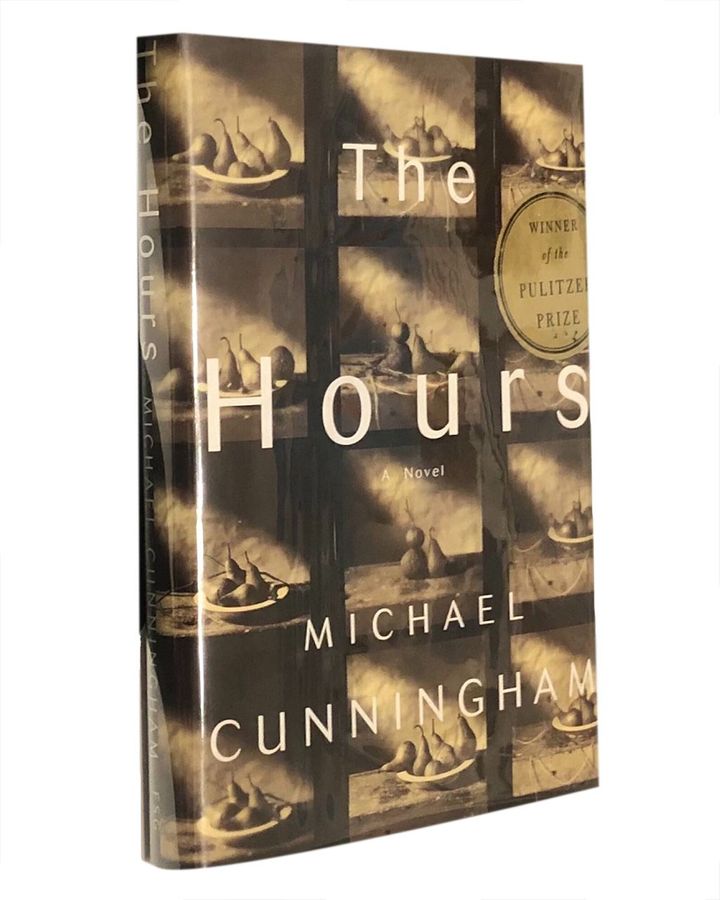
Michael Cunningham’s The Hours reinvented the image of Virginia Woolf by echoing her own literary style (Credit: Farrar, Straus and Giroux)
Enter Nicole Kidman stage left, cigarette in hand, enquiring after the flowers. Kidman and her performance as Woolf in the 2002 film The Hours – incorporating a much-maligned artificial proboscis – has come to define the popular image of Virginia Woolf in the 21st Century. However there are no distracting prosthetics in Michael Cunningham’s 1998 Pulitzer-prize winning novel on which the film is based. It is this book which has changed the image of Virginia Woolf in the cultural imagination for the last 25 years.
A trio of everywomen
Cunningham reinvented Woolf through literature itself. The Hours is a modern reinterpretation of Woolf’s 1925 novel Mrs Dalloway, which follows troubled politician’s wife Clarissa Dalloway through her “stream of consciousness” over the course of a day as she prepares to host a party. In The Hours, Dalloway’s thoughts are echoed by a trio of women in the 20th Century, from a fictionalised Virginia Woolf to Clarissa Vaughan, a contemporary Mrs Dalloway who, unlike her repressed 1920s counterpart, is able to live as a lesbian with her female partner in 1990s New York.
Placed between them is a 1950s American housewife called Laura Brown, inspired by Cunningham’s mother. Her name comes from Woolf’s 1924 essay Mr Bennett and Mrs Brown, in which Mrs Brown is an emblematic everywoman who “can be treated in an infinite variety of ways, according to the age, country, and temperament of the writer”. The three women in The Hours are all examples of this everywoman – just as the character Virginia describes how the novel she is writing is about, “A woman’s whole life, in a single day, and then that day, her whole life”.
These three narratives, overlapping and conflicting with each other, render The Hours a palimpsest – one can peel back the layers to find Cunningham’s own feelings, inspired as they were by Woolf’s own writing. It is a self-aware form of intertextuality, in that Cunningham does not literalise the story Woolf wrote, but weaves it together with other forms of reality, and brings the queer elements of her sensibility into the light as a celebration made possible decades after Woolf’s death.
The form of Cunningham’s The Hours is based on alternating chapters focusing on each of the three female characters. In the film adaptation, written by playwright David Hare and directed by Stephen Daldry, those chapters merge together through the visual grammar of cinema, allowing the narrative similarities to be more explicitly rendered through parallel editing. After the prologue depicting Woolf’s death, Hare establishes the three storylines in faster succession than Cunningham does in the book, superimposing locations and dates – Los Angeles 1951; Richmond, England 1923; New York City 2001 – and blending together extended montage sequences that move between the women’s different domestic environments.
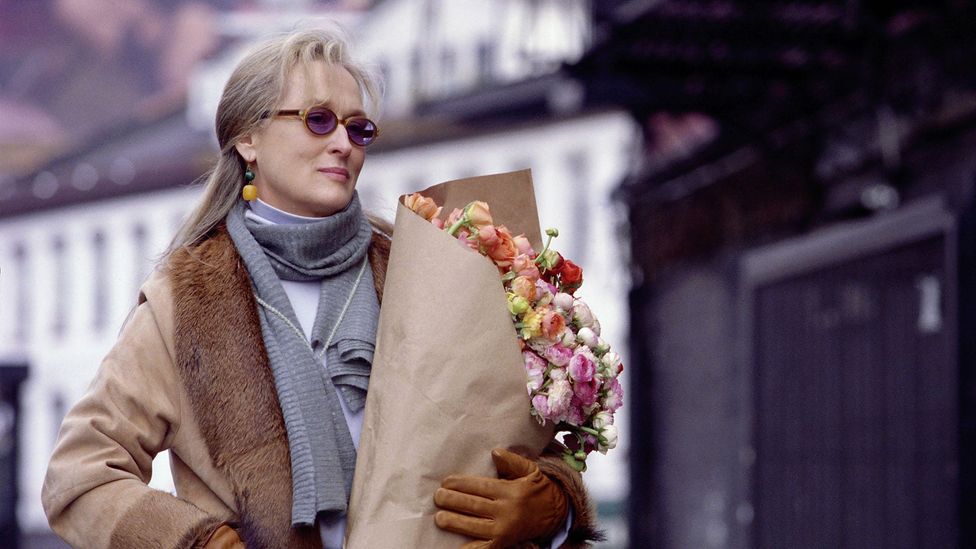
The film version of The Hours saw Meryl Streep play Clarissa Vaughan, a modern-day equivalent of Woolf’s own Mrs Dalloway (Credit: Alamy)
The effect of blurring the lives of the three women reaches its apotheosis in the recent opera adaptation which premiered at New York’s Metropolitan Opera last November. With music by Kevin Puts and a libretto by Greg Pierce, the opera is also the only iteration of The Hours which begins with Woolf in the process of writing rather than dying. Both novel and film start at the end – 28 March 1941, when Woolf filled her pockets with rocks and entered the River Ouse near Monk’s House. Cunningham quotes Woolf’s suicide note to Leonard directly, heard in voiceover in the film, in which she writes with the utmost clarity: “I don’t think two people could have been happier than we have been”.
Woolf scholar Professor Maggie Humm tells BBC Culture that the cultural focus on Woolf’s death has shaped modern perceptions of her life. Reflecting on the opening of The Hours, she says, “To look for previous moments or signs in her life in which the final act – the death – becomes the whole subject, is to do Woolf a disservice”.
Loving in triangles
When an author dies by suicide – such as Sylvia Plath, to take another example – there is a tendency to look for signs of inevitability of this fate in their life and work. It is regrettable that The Hours begins with Woolf’s death because the rest of the plot is about her life 16 years earlier. While she suffered a long-term mental illness, Woolf lived in a rich and colourful community of creativity. This was the focus of the 2015 BBC miniseries Life in Squares, written by Amanda Coe and starring Lydia Leonard as Virginia, which was fortunate to be able to use such real-life locations as Charleston in East Sussex, the country home of Woolf’s sister Vanessa Bell and her lover Duncan Grant
Like The Hours, the series moves between different periods in the lives of Woolf and her sister, contrasting their optimistic youth with their more fraught later years. To some extent bringing a positive light to their early life does work to counter the biographical trend to identify the seeds of her suicide. But Life in Squares doesn’t tap into the richness of Woolf’s creative mind like Cunningham does. Restricted by its pretence to naturalism, it lacks a stream of consciousness.
The title of the series comes from a much-repeated aphorism of Dorothy Parker, that the so-called “Bloomsberries” “lived in squares, painted in circles, and loved in triangles”. The final clause continues to capture popular imagination. The Woolfs and their friends engaged in what today many think of as startlingly modern approaches to queerness and polyamory. Woolf herself is typically labelled “bisexual” – a term she of course never used herself – largely due to her relationship with fellow writer Vita Sackville-West, wife of the politician Harold Nicolson. The rigidity of “triangles” and “bisexual” seems too reductive, however, given the ambiguity with which Woolf depicted sexuality in her work.
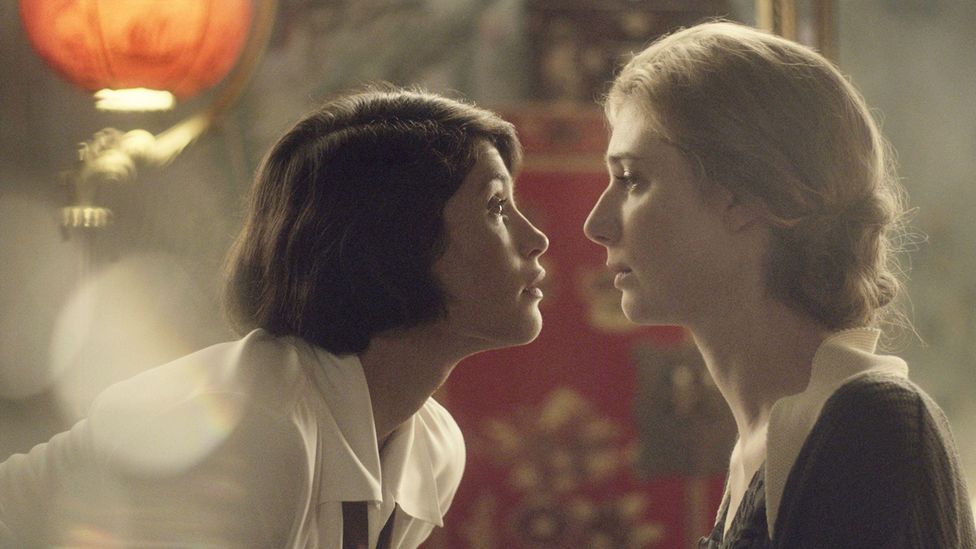
The 2018 film Vita and Virginia is among the less successful attempts to depict Virginia Woolf on page, stage or screen (Credit: Alamy)
Woolf’s relationship with Sackville-West is best illustrated through the letters they sent to each other. In 1992 the actress Eileen Atkins adapted the letters as a play titled Vita & Virginia in which she played Woolf opposite Penelope Wilton. Atkins developed a strong affinity to Woolf, having earlier played her in a stage monologue reading of Woolf’s famous 1929 essay A Room of One’s Own. Vita & Virginia was then adapted by writer-director Chanya Button for the screen in 2018, with Elizabeth Debicki starring as Woolf and Gemma Arterton as Sackville-West.
As signalled by the synth-pop score by Isobel Waller-Bridge, the film aimed to modernise the relationship between the two women. However, Button reduces the forbidden yearning and desire between them to little more than mild sexual activity. It is ultimately irrelevant that it is Woolf and Sackville-West portrayed within the film, given it tells us nothing of their creativity: it merely uses them as an excuse for lesbian representation for its own sake.
Speaking to BBC Culture, Dr Karina Jakubowicz, host of The Virginia Woolf Podcast, says, “The way we view Woolf’s sexuality has been affected by society’s understanding and acceptance of the LGBT+ community. In the 1980s she was embraced as a strictly lesbian heroine, but in later years it became more common to refer to her as a bisexual one. These days she’s often described as queer, which is an excellent term because it indicates her attitudes towards gender and sexuality at the same time.”
However what is queer in Virginia Woolf is not explicit. Her queerness often comes through indirectly, as a sensibility and aesthetic of her writing. Sex is both there and not there. Think of Clarissa Dalloway recalling the moment she kissed her old friend Sally Seton on the lips as a young woman: “the most exquisite moment of her whole life passing a stone urn with the flowers in it”. Similarly, there is no sex in The Hours, only an illicit kiss between housewives that sparks an existential crisis, and an unquestioned love between old friends. What this says of Woolf’s sexuality is purely speculative. A phrase which recurs throughout Woolf’s work, in the midst of swathes of poignant emotional text, is “she thought”. But while we might imagine what Woolf’s thoughts are, we should banish any pretence to know them.
Between The Acts
In her essay The Cinema, published in The Nation and Athenaeum in 1926, Woolf wrote that when we watch films, “We see life as it is when we have no part in it. As we gaze we seem to be removed from the pettiness of actual existence”. Watching Woolf as a character on a screen or stage, we do not directly interact with the woman herself but a facsimile of someone who is no longer a tangible part of our present existence. As Woolf writes, when we watch real events restaged on screen, “We are beholding a world which has gone beneath the waves”.
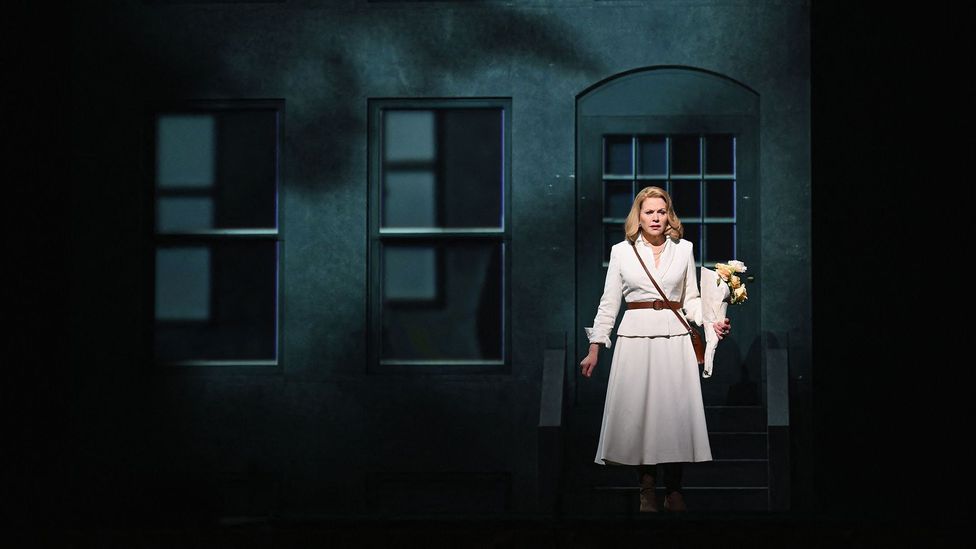
The Hours opera adaptation was acclaimed when it made its debut at New York’s Met Opera last year (Credit: Getty Images)
In The Hours, Cunningham calls attention to the immediacy of real life and how it will soon fade into altered memory. When Clarissa goes to get the flowers for her party, she thinks to herself, “Here is the world, and you live in it, and are grateful. You try to be grateful”. The sentiment is echoed again in Clarissa’s thoughts at the end of the novel, when the elderly Laura Brown comes to visit having heard that her son, and Clarissa’s close friend, Richard, has died: “Here is the world, increasingly managed by people who are not you”. Woolf in her essay on cinema appears to observe that in our existence we surrender ourselves to the perspectives of others. In The Hours, the characters seem to be aware of the fact that their essence is partly contained within the eye of the beholder – Cunningham writes a Virginia Woolf who knows that one day she will be fictionalised, be it in novels, biographies, or films, and that they will never actually be her.
In the 2022 Metropolitan Opera production of The Hours, directed by Phelim McDermott, the three lead characters come closer together than before. Their respective domestic sets move about on the stage, sometimes simultaneously, which is mirrored in the music. By contrast to Philip Glass’s lavish, swelling score for the film version of The Hours, Kevin Puts uses distinct leitmotifs in the opera to reflect the different eras and personae of the three women. If there is a hint of Glass’s influence in the score, it is around the modern Clarissa to whom late 20th-Century American minimalism is most appropriate. But there’s something more classical to Woolf’s arias, and the 1950s feminine mystique of Laura Brown is introduced by a breeze of cool jazz. Where the acting in the film is quite muted, Puts pushes the singers into bright, bold vocal performances which resonate across the triptych of periods.
The culmination of these threads is a trio sung by the leads. With Renée Fleming as Clarissa Vaughan, Kelli O’Hara as Laura Brown, and Joyce DiDonato as Virginia Woolf, their voices come together where in literature and cinema their conversation must be kept spatially distant. The trio riff on Clarissa’s “Here is the world…” line, their different voice types overlapping as the panels of the triptych finally bleed together. Woolf sits in the centre, creating the impression that she is able to transcend time to be here in the world as now as she was then. Woolf’s presence in the present day is of course an illusion – we see merely the waves that cover Woolf’s real world.
This wave in the mind
Woolf wrote in her diary in July 1935, “How queer to have so many selves. How bewildering!” The splitting of Woolf’s cultural persona into three fictional characters is Cunningham’s most successful device, acknowledging the multiplicity of the author’s self-perception whilst not making any claim to authenticity. Cunningham borrows the structure of The Hours from Woolf herself, from her 1931 novel The Waves, in which multiple streams of consciousness come together.
In 2015, choreographer Wayne McGregor created a ballet set to music by Max Richter called Woolf Works. It concludes with a 22-minute act inspired by The Waves, one giant crescendo of ebb and flow with the lead dancer playing Woolf becoming submerged by the huge internal overwhelm of inexpressibility – the words become stuck in the mind. Writing to Vita Sackville-West in 1922, Woolf observed that style is “all rhythm”, and that for her, “A sight, an emotion, creates this wave in the mind, long before it makes words to fit it”.
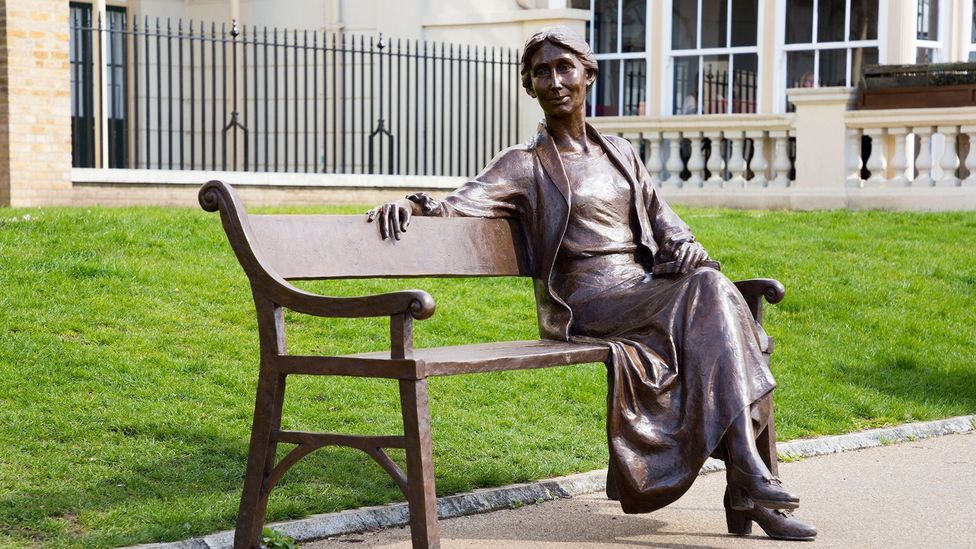
Laury Dizengremel’s bronze statue of Woolf in Richmond, South London allows passers-by to sit with her (Credit: Alamy)
As in The Hours, this sequence in Woolf Works gestures towards Woolf’s death, opening with a reading of her suicide note. It is a bookend to the ballet’s beginning, which features the only recording of Woolf’s voice, a BBC radio broadcast from 1937 called “On Craftsmanship”. In it, she expresses the challenges of using English in writing, so enriched with “echoes, memories, associations” that it becomes impossible to deploy them to express a singular thought without triggering a thousand others. Woolf’s legacy is to be tied so intimately to language that her image holds symbolic power in works like The Hours decades after her own lifetime. She continues to give an interpretative language to others.
In the broadcast, Woolf asks, “How can we combine the old words in new orders so that they survive, so that they create beauty, so that they tell the truth? That is the question”. The answer, as provided by Cunningham in The Hours, is to retell the old stories in new ways, to place one foot in the past whilst acknowledging that we have no choice but to keep the other in the present. We lose a sense of the “real” Virginia Woolf, whoever she might have been, but it keeps her work fresh and alive in the way she so desperately wanted it to be.
In A Room of One’s Own, Woolf reminds us that we cannot write without laying down flowers at the tombs of the authors, poets, and playwrights who came before us. “For masterpieces are not single and solitary births; they are the outcome of many years of thinking in common, of thinking by the body of the people, so that the experience of the mass is behind the single voice.” How Woolf is perceived depends on what we want her to be, so that when a passer-by sits on the bench in Richmond with her statue, the conversation can hold whatever meaning they desire. Like the artist Lily Briscoe at the end of her 1927 novel To the Lighthouse, Woolf had her vision. Now we must have one of our own.
If you liked this story, sign up for the weekly bbc.com features newsletter, called The Essential List. A handpicked selection of stories from BBC Future, Culture, Worklife and Travel, delivered to your inbox every Friday.
If you would like to comment on this story or anything else you have seen on BBC Culture, head over to our Facebook page or message us on Twitter.








